Animated Series
Milky Way Galaxy

Milky Way (TOS-01)
The Milky Way was a spiral galaxy approximately 100 thousand light years across, divided into four quadrants, designated by the Greek letters Alpha, Beta, Gamma, and Delta, and were arbitrarily divided using Earth as a reference point. As a result, Earth, and the Sol Sector, fell in the Alpha Quadrant, while the Vulcan and Andorian Sectors fell in the Beta Quadrant. The Gamma and Delta Quadrants remained largely unexplored by the early 25th century, though knowledge of those regions was greatly increased thanks to the Bajoran wormhole and the U.S.S. Voyager NCC-74656, respectively.[3] The galaxy was surrounded by a nearly-impenetrable energy field, dubbed the Galactic Barrier, with unpredictable neurogenic properties.[1, 3] Likewise, the core of the galaxy is surrounded by a distinct but related field, dubbed the Great Barrier.[2, 3]
› Continue reading
15 Lyncis System
The 15 Lyncis System was located in the constellation Lynx, as seen from Earth. Inhabited planets in the system included Cait, homeworld of the Caitians.[1]
References
- 1. “Star Trek: Star Charts.” Star Trek. Novel. 2002. Pocket Books.
Orions
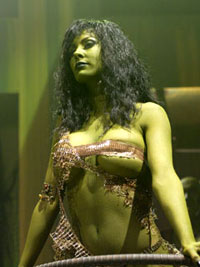
Orion female (ENT-80)
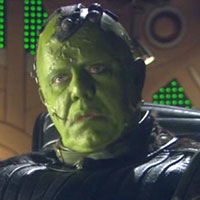
Orion male (ENT-93)
Slave traders who dealt in “green animal women.”[1] The supposed “animal” nature of Orion women, however, was discovered to be a pretense by the Enterprise NX-01 in 2154; Orion women produced extremely powerful pheromones, which they were able to use to disable Human women and make men—both Human and Orion—susceptible to suggestion. Vulcan women were apparently immune, while Denobulan men were sent into an unnatural sleep cycle.[3] Orion territory was located adjacent to the Klingon Empire, and the region where Klingon and Orion territory met was known as the Borderland.[2]
Notable Orions:
- Harrad Sar[3]
- Navaar[3]
References
- 1. “The Cage.” Star Trek, Episode 0. Television. 1965 (Unaired).
- 2. “Borderland.” Star Trek: Enterprise, Episode 80. 29 October 2004.
- 3. “Bound.” Star Trek: Enterprise, Episode 93. 15 April 2005.
Humans
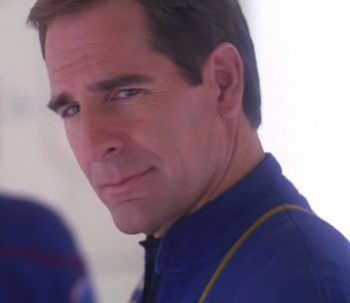
Jonathan Archer (ENT-31)
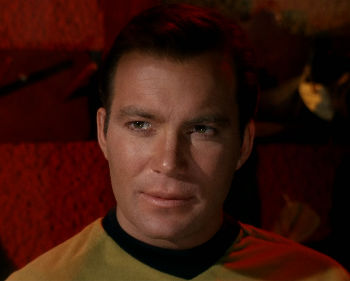
James T. Kirk (TOS-05)
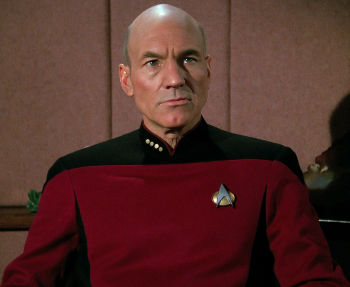
Jean-Luc Picard (TNG-165)

Benjamin Sisko (DS9-541)
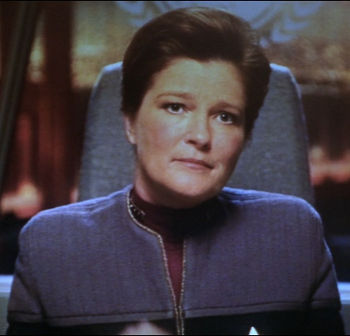
Kathryn Janeway (ST-10)
Species originating on Earth. According to the Talosians in the 2250s, “The customs and history of [Humans] show[s] a unique hatred of captivity. Even when it’s pleasant and benevolent, [they] prefer death. This makes [them] too violent and dangerous a species for [the Talosians’] needs.” The Talosians had scanned the U.S.S. Enterprise NCC-1701‘s databanks, and had gleaned quite a bit of information about Human history.[1]
Notable Humans
References
- 1. “The Cage.” Star Trek, Episode 00. Television. 1965 (Unaired).
- 2. “Where No Man Has Gone Before.” Star Trek, Episode 01. Television. 22 September 1966.
- 3. “Encounter at Farpoint.” Star Trek: The Next Generation, Episodes 101-102. Television. 28 September 1987.
- 4. “Emissary.” Star Trek: Deep Space Nine, Episodes 401-402. Television. 4 January 1993.
- 5. “Caretaker.” Star Trek: Voyager, Episodes 101-102. Television. 16 January 1995.
- 6. “Broken Bow.” Star Trek: Enterprise, Episodes 01-02. Television. 26 September 2001.
Andorians

Shran (ENT-07)
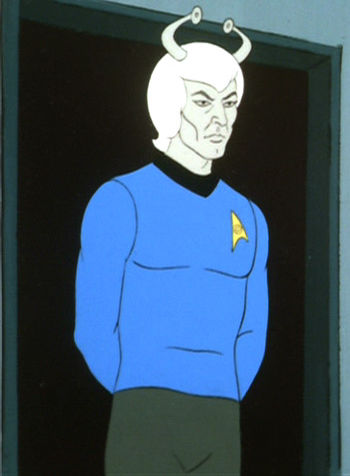
Thelin (TAS-03)

Talas (ENT-89)
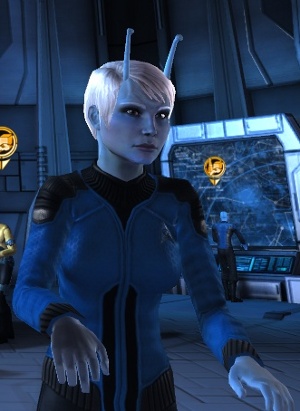
Esheli (STO)
These humanoid Federation members are blue-skinned in appearance and have bilateral antennae and characteristically white hair.[1] Andorians have a higher metabolism than humans[15]. Because of Andorians’ unusual physiology, intravenous injections are not possible; instead, a doctor must use intra-muscular injections.[2]
Andorian antennae are used, at least in part, for balance. An Andorian is partially disabled and unable to function immediately following the loss of an antenna, but is typically able to compensate after a day or two. Antennae can take up to nine months to regrow, although that can be completed in half the time with electrical stimulation and cranial massage therapy. Loss of antennae is a humiliating experience for an Andorian.[15] An Andorian’s antennae can also detect subtle shifts in temperature, electrical fields, and emotion.[16] The movement of an Andorian’s antennae can also indicate emotional states. An Andorian will sometimes point their antennae at a potential mate to signify attraction, though it is unclear if this is a voluntary or involuntary response.[12]
› Continue reading
Adams, Stanley

Actor:
- Cyrano Jones.[1, 2, 3]
This page is dedicated to the memory of Stanley Adams.
References
Dilithium
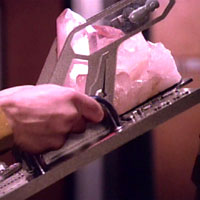
Dilithium (TNG-147)
Crystalline substance used in warp propulsion systems to regulate the matter/antimatter reactions that provide the energy necessary for faster-than-light speed. Naturally occurring dilithium was extremely rare and was mined on only a few planets, such as Coridan,[1] Troyius[2] and Rura Penthe.[4] In 2286, a method of recrystalizing dilithium was discovered, reducing the need for mining new deposits of the mineral.[3]
References
- 1. “Journey to Babel.” Star Trek, Episode 44. Television. 17 November 1967.
- 2. “Elaan of Troyius.” Star Trek, Episode 57. Television. 20 December 1968.
- 3. Star Trek IV: The Voyage Home. Film. 26 November 1986.
- 4. Star Trek VI: The Undiscovered Country. Film. 6 December 1991.
Computer Interface
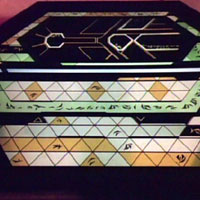
Custodian Controls (TNG-118)
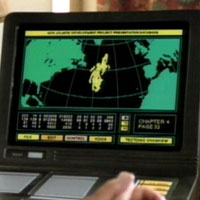
Computer Interface (TNG-178)

Holographic Computer Interface (TNG-107)
![]()
Iconic Display Console (TNG-193)
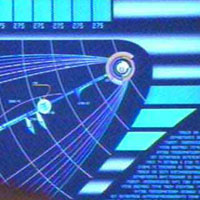
TCARS Interface (VOY-218)

Computer Interface (TNG-178)
Method of interacting with a computer system. The computers aboard the U.S.S. Enterprise NCC-1701 utilized tactile buttons and knobs, as well as motion-sensitive displays and consoles.[1] By the 24th century, touch-sensitive display panels had largely replaced the tactile interfaces,[2] though there were also some uses for holographic interfaces.[3]
References
- 1. “The Cage.” Star Trek, Episode 00. Television. 1965 (Unaired).
- 2. “Encounter at Farpoint.” Star Trek: The Next Generation, Episodes 101-102. Television. 28 September 1987.
- 3. “The Last Outpost.” Star Trek: The Next Generation, Episode 107. Television. 19 October 1987.
Computer
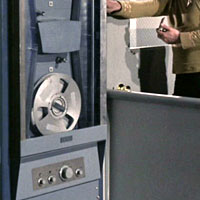
Data storage, retreival and computational device. Early computers on Earth were quite large and used magnetic tape to store information.[1]
References
Alice in Wonderland


Children’s story, written by Lewis Carroll. The U.S.S. Enterprise NCC-1701 encountered a recreation of Alice and the White Rabbit, characters from the story, on what was dubbed an “Amusement Park” Planet in 2266.[1]
References
Categories
- Animated Series (60)
- Articles (28)
- Books (447)
- Cast & Crew (79)
- Comics (22)
- DS9 (328)
- Early Voyages (125)
- Education (5)
- Enterprise (373)
- Excelsior (36)
- Food (19)
- Games (223)
- Klingon (70)
- Library (1,543)
- Logs (593)
- Lost Era (55)
- Medicine (18)
- Merrimac (1)
- Mirror (35)
- Miscellaneous (13)
- New Frontier (54)
- Next Generation (635)
- Original Series (681)
- Personnel (436)
- Places (369)
- Politics (12)
- Recreation (10)
- SCE (41)
- Science (1)
- Shatnerverse (9)
- Ships (455)
- Site Updates (98)
- Starfleet Academy (86)
- Stargazer (42)
- STO (61)
- Technology (45)
- Titan (59)
- To Boldly Go (1)
- TV/Film (214)
- Uncategorized (4)
- Vanguard (76)
- Voyager (236)
- Weapons (27)
- Xenology (54)